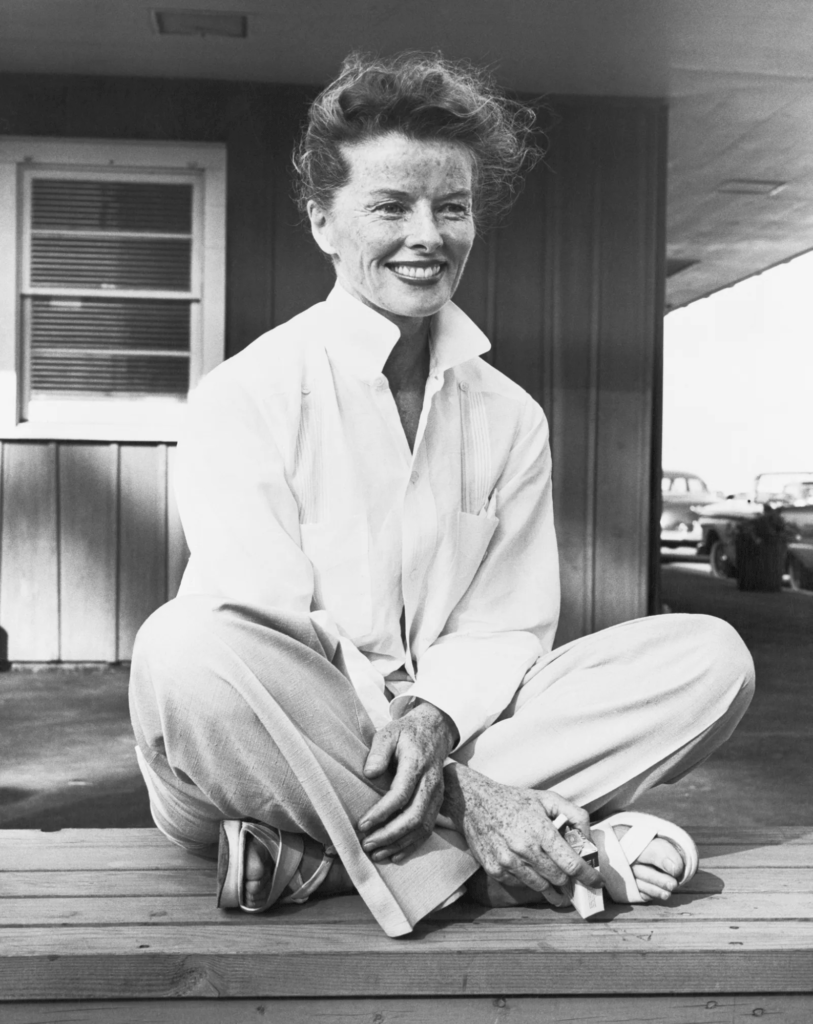“I have not lived as a woman. I have lived as a man”, Hepburn told Barbara Walters in 1981.
_________________________________
115 years after Katharine Houghton Hepburn, an outspoken, sharp-tongued American actress was born in Hartford, Connecticut, it is still remarkable how vehemently this screen icon rebelled against traditional gender norms.

Source: Footwear News
In her childhood, Hepburn was often described as a tomboy and, as she grew older, she was mostly conceived as ‘too masculine’ or ‘too tough’, mainly because of her androgynous, ‘unladylike’ style. Her film career started in the early 1930s, a deeply conservative era in which gender bias prevailed in the American nation and women’s inferiority was imprinted in all forms of culture: movies, theatre, music, health care, education and of course clothing. Attire, in particular, was conceived as a manifestation of one’s own gender, and it was technically illegal for women to wear trousers. In fact, those who were dauntless and brave enough to ‘violate’ this ban and wear ‘masculine’ outfits publicly, were arrested and marked by their surroundings as deviant or even homosexuals. It was the same period when Sigmund Freud’s theories regarding femininity, female masculinity and female perversion spread. According to Freud, women’s desire to dress like men was reduced to a symbol of ‘penis envy’ and a mark of certain lesbianism. Their cross-dressing style was interpreted as deviant, aberrational and sexually abnormal rather than diverse and pioneering.

Source: vanityfair.com
In all this paranoia surrounding women’s appearance and sexuality, Hepburn was absolutely a rarity in the 1930s. With an unapologetic sense of style, she stepped out to her movies in full pantsuits, raising quite a few eyebrows and hitting the silver screen in 1932. Her casual slacks, button-up shirts and practical shoes were decidedly unconventional, and they reflected her own mentality, matching the life she led. “I put on pants 50 years ago and declared a sort of middle road” she famously stated in a 1981 interview, revealing an attitude far ahead of its time. Heavily influenced by her figure, Vogue was the first fashion magazine that featured women in pants in 1939 and 47 years later, in 1986, Katharine received an award from the Council of Fashion Designers of America. Clearly, then, a pioneer of the American sport-wear aesthetic, her contribution to women’s fashion history is impressive and admirable.
But Hepburn was not simply a fashion icon. Over the course of her long and prolific career, she challenged women’s traditional and repressive roles as housewives, nurturing mothers and loyal, faithful lovers by acting roles of independent, educated and affluent female characters. She endeavored to spread a spirit of modernism and independence in a period when Economic Depression reinforced the idea that women’s proper place was the domestic sphere. Thus, being an important influential figure and a role model for women, Hepburn demonstrated that it is possible for ladies to survive not only in the competitive field of the film industry, but also in other male-dominated occupations.

Source: glamour.com
Vigorous and independent, both in thought and action, Hepburn sought to derive dynamism and power rather than sexuality from her fierce screen presence. Unlike other trouser-wearing figures of the era, like Greta Garbo, Marlene Dietrich, Mozelle Britton and Fay Wray, Hepburn stood in stark contrast to this ‘undeniable erotic allure’, according to William J. Mann. She was often characterized as ‘angular and sexless’ as she was blatantly interested not in glamour, but in agency and comfort. Although she possessed some key features of a ‘femme fatale’ character in most of her films, like vigor, self-confidence and energy, she lacked other important aspects like seductiveness, eroticism, and destruction of the male protagonist. Underneath her beautiful external appearance, lay a soulful depth of intelligence and fierce independence.
Eccentric and unusual as she was, Katharine developed a peculiar persona outside the confines of the studio system, shedding light on feminist issues, women’s sexuality and oppression. As Mary McNamara aptly noted in the Los Angeles Times, she was a star of the golden age of Hollywood and “the patron saint of the independent American female”.
A mere wonder is: can her rarity be established?
Katharine Houghton Hepburn, born on May 12, 1907; died on June 29, 2003.
_________________________________
References
https://www.vanityfair.com/hollywood/2016/05/katharine-hepburn-style-pants
https://bust.com/style/196108-katharine-hepburn-pants-hollywood-fashion-feminism-history.html
Source of header image: https://www.thecut.com/2012/08/katharine-hepburn-look-book.html
Γεννημένη το ’99 και μεγαλωμένη στο γραφικό Μέτσοβο, είμαι πτυχιούχος του τμήματος Αγγλικής Γλώσσας και Φιλολογίας στο ΑΠΘ. Το διάβασμα, η ξενόγλωσση λογοτεχνία, η ζωγραφική και η φυσικά η γραφή εντάσσονται στα έντονα ενδιαφέροντά μου και αποτελούν τις πηγές έμπνευσής μου. Μεταξύ άλλων, επέλεξα να είμαι και συγγραφέας γιατί λατρεύω να αποτυπώνω και να εκφράζω ό,τι μου υπαγορεύει ο νους μου.









0 Σχόλια